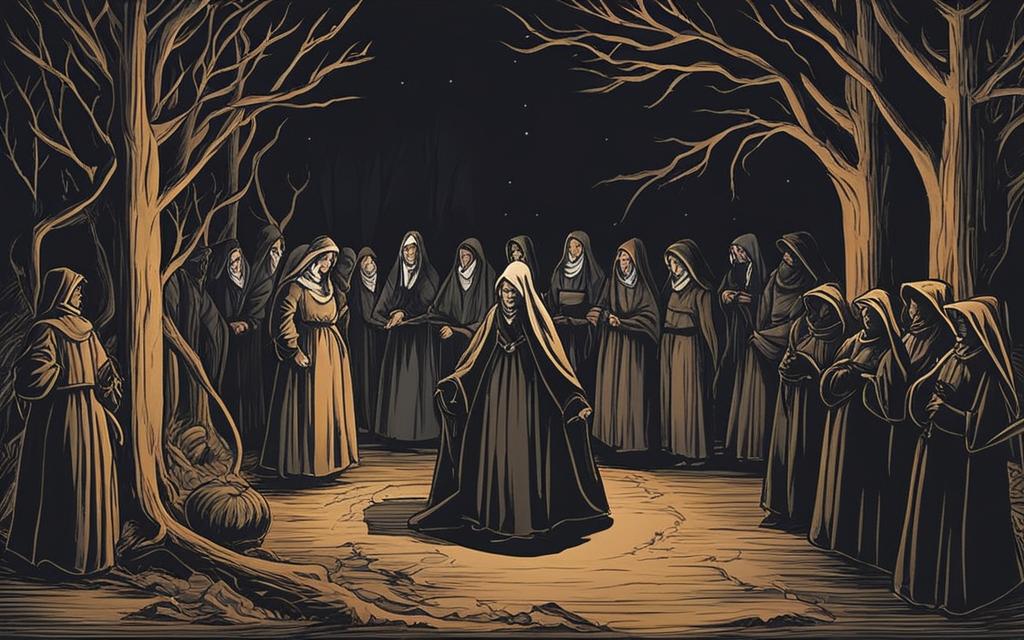As a professional copywriting journalist, I am excited to explore the immersive world of Arthur Miller’s classic play, The Crucible, and specifically focus on Act 1. The crucible audiobook act 1 is a captivating story that takes place during the Salem witch trials within the Puritan society.
Through our detailed analysis of Act 1, we will unravel the dramatic tension that permeates the narrative, comprised of an intricate web of secrets and lies. It is a masterful display of Miller’s storytelling skills that captivates and engages audiences to this day.
In the following sections, we will explore the historical context of the Salem witch trials, analyze the dramatic tension, and examine the unique advantages of experiencing The Crucible as an audiobook. We will also provide a comprehensive analysis of Act 1, delving into the intricacies of the plot, themes, and symbolism.
Join me as we embark on a journey of discovery into the timeless relevance of Miller’s work. Let’s begin by exploring the fascinating world of The Crucible Audiobook Act 1.
Understanding the Salem Witch Trials
As I delve into Act 1 of The Crucible audiobook, I can’t help but wonder about the real events that inspired Arthur Miller’s masterpiece. The Salem witch trials, which took place in colonial Massachusetts from 1692 to 1693, have long captivated the public imagination, and for good reason. The accusations of witchcraft, the trials, and the subsequent executions of men and women accused of consorting with the devil, remain a haunting reminder of a dark time in American history.
To truly appreciate The Crucible, it’s important to understand the Puritan society in which the story takes place. The Puritans were a religious group that emigrated from England to America in the early 1600s. They believed in predestination, the idea that God had already chosen who would be saved and who would be damned. This belief led to a strict moral code and a fear of anything that could be interpreted as a sign of the devil’s presence.
It was in this context that the accusations of witchcraft began to spread in Salem. The first accusations were made by young girls who claimed to have been possessed by the spirits of accused witches. Hysteria and paranoia quickly took hold, and soon anyone could be accused of witchcraft, regardless of their standing in the community. The trials that followed were marked by dubious tactics, including the use of spectral evidence and forced confessions, that resulted in the conviction and execution of innocent people.
“More than two hundred people were accused of witchcraft during the Salem witch trials, and twenty were executed.”
As we listen to Act 1 of The Crucible, we can see how Miller masterfully weaves together historical fact and dramatic fiction to create a powerful commentary on the dangers of groupthink, intolerance, and the abuse of power. The Puritan society he depicts may seem far removed from our modern world, but the themes and issues it raises continue to resonate today.
So as we explore The Crucible audiobook, let’s keep in mind the historical context of the Salem witch trials and the impact they had on the Puritan society of the time. It’s only by understanding the past that we can truly appreciate the significance of Miller’s work.
Unraveling the Dramatic Tension
As I delved deeper into Act 1 of Arthur Miller’s classic play, The Crucible, I found myself completely engrossed in the intricate web of secrets and lies that fuel the dramatic tension of the story. The play is a masterful display of Miller’s storytelling skills, which highlight the themes of power, manipulation, and truth that are still relevant today.
At the heart of the play is the conflict between the Puritan society’s strict moral code and the characters’ personal desires and ambitions. As the story unfolds, the characters’ motivations and fears come to light, creating a suspenseful narrative that keeps readers on the edge of their seats.
The play’s exploration of the Salem witch trials adds to the dramatic tension, as the accusations and paranoia surrounding witchcraft accusations threatened to tear the community apart. Miller’s attention to historical accuracy also adds to the immersive experience, deepening the audience’s understanding of the social and religious factors that contributed to the hysteria of the times.
Overall, Act 1 of The Crucible is a shining example of a classic play that still resonates with audiences today. The dramatic tension that permeates the story keeps readers engaged and invested in the fate of the characters, while the exploration of power and truth adds layers of depth to the narrative.

“I have seen marvels in this court. I have seen people choked before my eyes by spirits; I have seen them stuck by pins and slashed by daggers.” -Abigail Williams, Act 1
Through the eyes of the characters, we see the devastating effects of manipulation and the lengths people will go to protect their interests. The dramatic tension of Act 1 is a testament to Miller’s ability to craft a compelling story that stands the test of time.
Exploring the Audiobook Experience
As I delved into The Crucible audiobook, I was amazed at how much more immersive the experience was compared to simply reading the text. By listening to the story unfold through narration, I found myself fully immersed in the world of the play, captivated by the performances of the voice actors.
The impact of sound effects and music further added to the dramatic tension, drawing me in and keeping me engaged throughout. I found myself on the edge of my seat as the plot unfolded, eager to discover what would happen next.
If you’re curious to explore The Crucible as an audiobook, you’re in luck. As part of our free audiobook exploration, we have provided a link where you can access a free audiobook version of Act 1. Simply follow the link to discover the unique advantages of experiencing this classic play in a brand new way.
Analyzing Act 1 in Depth
Act 1 of The Crucible sets the stage for the captivating drama that unfolds throughout the play. From the initial accusations of witchcraft to the introduction of key characters such as John Proctor and Abigail Williams, the first act draws the reader into the world of Salem with both its beauty and its darkness.
One of the central themes of Act 1 is power, particularly the abuse of power by those in authority. The Reverend Parris, for example, is more concerned with his reputation than the well-being of his daughter, Betty, who has fallen into a mysterious coma. Similarly, Abigail Williams manipulates her position as a witness to wield power over others and to further her own desires.
Another theme that permeates Act 1 is the struggle for truth. The characters grapple with the question of who to believe and what to believe. This struggle is most evident in the conflict between John Proctor and Reverend Parris, as well as in the accusations of witchcraft that threaten the community.
“I cannot blink what I saw, Abigail, for my enemies will not blink it. I saw a dress lying in the grass.” – Reverend Parris
The use of symbolism in Act 1 also adds depth and richness to the narrative. The forest, for example, symbolizes the wilderness of the unknown, while the compact made between the girls adds a layer of secrecy and intrigue to the story.
Overall, Act 1 lays the foundation for a gripping drama that explores the themes of power, manipulation, and truth. By delving into the intricacies of the plot, themes, and symbolism, readers can gain a deeper understanding of the timeless relevance of Arthur Miller’s classic play.
Conclusion
In conclusion, I hope that this journey through Arthur Miller’s The Crucible Audiobook Act 1 has been as immersive and thought-provoking for you as it has been for me. Through examining the historical context and dramatic tension, exploring the advantages of the audiobook experience, and analyzing Act 1 in depth, we have gained a deeper understanding of Miller’s masterful storytelling.
The themes of power, manipulation, and truth remain as relevant today as they did during the Salem witch trials, reminding us of the dangers of blind faith and the importance of questioning authority. The Crucible serves as both a warning and a testament to the strength of the human spirit in the face of oppression.
I encourage you to continue exploring the world of The Crucible and to delve into the subsequent acts of the play. Whether through reading, listening, or watching, this timeless work of literature is sure to leave a lasting impact.



